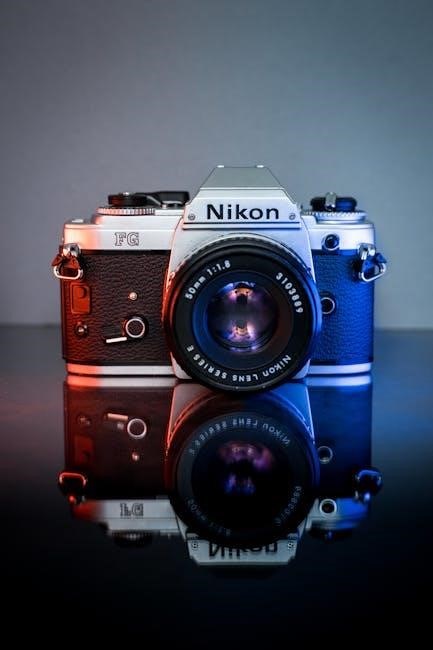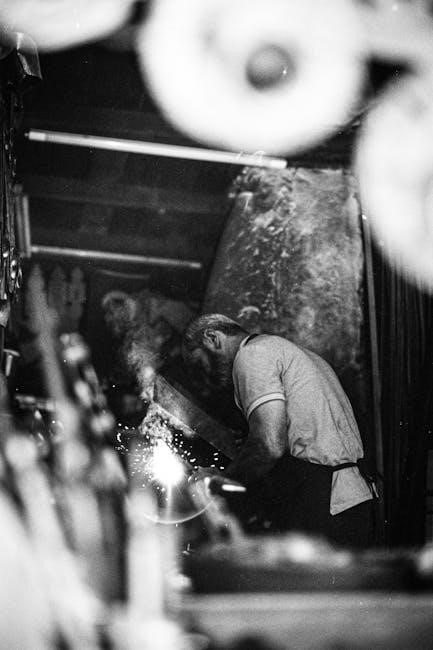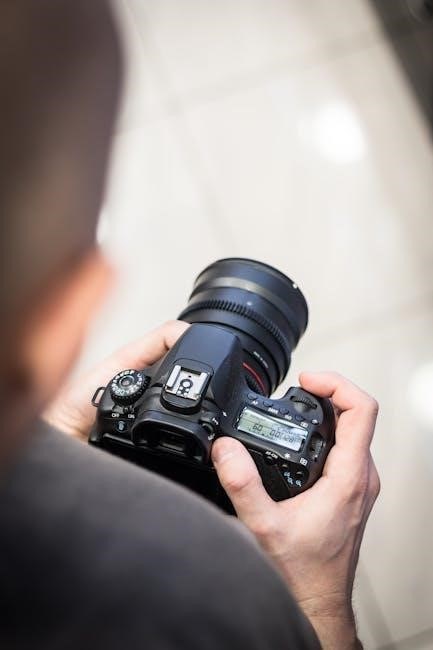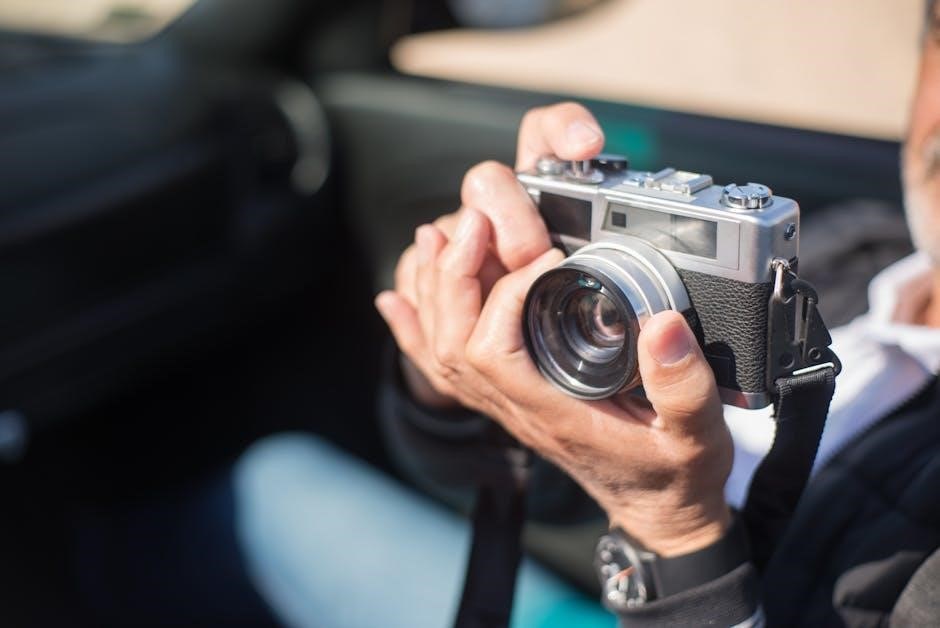The Nikon D700 manual is a comprehensive guide designed to help users master the camera’s advanced features‚ settings‚ and shooting techniques. It covers everything from basic operations to complex customization options‚ ensuring photographers of all skill levels can optimize their camera’s performance. This manual is essential for understanding the D700’s capabilities and enhancing your photography experience.
1.1 Overview of the Nikon D700 Camera
The Nikon D700 is a professional-grade DSLR camera featuring a 12.1-megapixel full-frame sensor‚ designed for high-resolution imaging and excellent low-light performance. It incorporates Nikon’s EXPEED image processing engine for enhanced color accuracy and noise reduction. The camera is built with a durable‚ weather-sealed magnesium alloy body‚ making it suitable for challenging environments. Targeted at professional photographers and advanced enthusiasts‚ the D700 offers advanced autofocus with a 51-point system‚ manual controls‚ and compatibility with a wide range of Nikon lenses and accessories. Its robust design and versatile features make it a reliable tool for capturing high-quality images in various photography genres.
1;2 Importance of the Manual for Optimal Camera Use
The Nikon D700 manual is indispensable for unlocking the camera’s full potential‚ providing detailed insights into its advanced features and settings. It serves as a comprehensive guide for understanding the camera’s functionality‚ from basic operations to complex customization. The manual explains how to utilize features like autofocus modes‚ metering systems‚ and shooting techniques effectively. Without it‚ users may miss out on optimizing the camera’s performance for their specific needs. It also offers troubleshooting tips and maintenance advice‚ ensuring the camera operates at its best. By studying the manual‚ photographers can enhance their skills and achieve superior results in various photography scenarios;

Accessing the Nikon D700 Manual
The Nikon D700 manual is accessible via official Nikon websites‚ trusted third-party sources like ManualsDir‚ or the Nikon Manual Viewer 2 app for mobile devices.
2.1 Sources to Download the Nikon D700 Manual
The Nikon D700 manual can be downloaded from Nikon’s official website‚ trusted third-party sites like ManualsDir‚ or through the Nikon Manual Viewer 2 app. These sources provide free access to the 472-page PDF manual in English. The official Nikon website ensures authenticity‚ while ManualsDir offers a straightforward download process without registration. The Manual Viewer 2 app allows mobile users to access the guide conveniently on iOS and Android devices. Additionally‚ the manual is available on various photography forums and review sites‚ ensuring widespread accessibility. Always verify the source’s reliability to avoid unauthorized or outdated versions of the manual.
2.2 Understanding the PDF Format and Its Benefits
The Nikon D700 manual is available in PDF format‚ offering portability‚ consistency‚ and ease of use. PDFs can be viewed on any device with a PDF reader‚ ensuring accessibility. This format preserves the document’s layout and formatting across devices‚ maintaining clarity. PDFs also support features like text search‚ bookmarks‚ and hyperlinks‚ making navigation intuitive. Additionally‚ PDFs can be printed consistently‚ providing a reliable physical reference. The format’s security features‚ such as password protection‚ safeguard the document. Free software like Adobe Reader enables universal access. Overall‚ the PDF format enhances the usability and accessibility of the Nikon D700 manual‚ making it an ideal choice for users worldwide.
Key Features Covered in the Nikon D700 Manual
The Nikon D700 manual details advanced shooting modes‚ autofocus systems‚ metering options‚ and customization features. It provides guides for optimal camera use and troubleshooting common issues effectively.
3.1 Advanced Shooting Modes and Customization Options
The Nikon D700 manual explores advanced shooting modes such as Manual‚ Aperture Priority‚ and Shutter Priority‚ offering precise control over exposure settings. These modes enable photographers to tailor their shots to specific lighting conditions and creative goals. Additionally‚ the manual highlights extensive customization options‚ allowing users to personalize camera buttons‚ menus‚ and profiles to suit their workflow. This flexibility ensures that photographers can streamline their process and access frequently used settings quickly. By mastering these features‚ users can unlock the full potential of the D700‚ achieving professional-grade results with ease and efficiency. The manual provides detailed guidance to help photographers make the most of these advanced capabilities;
3.2 Autofocus Modes and Metering Systems Explained
The Nikon D700 manual delves into the camera’s autofocus modes‚ including Single-Servo AF‚ Continuous-Servo AF‚ and Manual Focus‚ each designed for different shooting scenarios. It also explains the advanced metering systems‚ such as the 3D Color Matrix Metering II‚ which ensures accurate exposure in various lighting conditions. The manual provides insights into how these systems work together to enhance focus and exposure precision‚ helping photographers achieve sharp‚ well-balanced images. Understanding these features allows users to adapt to dynamic environments and capture high-quality shots consistently. The detailed explanations in the manual empower photographers to utilize the D700’s autofocus and metering capabilities effectively‚ ensuring optimal results in every situation.

Camera Setup and Configuration
The Nikon D700 manual guides users through initial setup and configuration‚ ensuring optimal performance. Customize settings to suit your photography style and shooting preferences for exceptional results.
4.1 Initial Setup Steps for the Nikon D700
The Nikon D700 manual outlines essential initial setup steps to ensure smooth operation. Begin by inserting the battery‚ charging it fully‚ and formatting the memory card. Navigate to the menu to set the language‚ date‚ and time. Select the appropriate shooting mode‚ such as Manual or Aperture Priority‚ based on your needs. Attach a compatible lens‚ ensuring it is properly mounted. For manual focusing‚ use the focus ring and confirm focus using the in-camera indicators. Familiarize yourself with the camera’s buttons and dials to customize settings efficiently. Finally‚ review the manual’s guidelines for optimal performance and troubleshooting common issues during setup. Proper initialization ensures a seamless photography experience with the Nikon D700.
4.2 Configuring Camera Settings for Different Shooting Scenarios
Configuring the Nikon D700 for various shooting scenarios requires adjusting settings to match the environment and desired results. For portraits‚ use Aperture Priority mode with a wide aperture to blur backgrounds. In low-light conditions‚ increase ISO sensitivity and enable noise reduction. For action photography‚ switch to Continuous Autofocus and a fast shutter speed. Landscape photography benefits from Manual mode‚ a small aperture‚ and tripod use. Adjust white balance to match lighting conditions‚ such as daylight or indoor settings. Utilize the built-in flash or external units for additional lighting control. Customizing settings ensures optimal image quality and adaptability to diverse photographic situations‚ making the D700 versatile for any shoot.
Shooting Modes and Techniques
The Nikon D700 offers versatile shooting modes and techniques to capture stunning images. Explore Manual‚ Aperture Priority‚ and Shutter Priority modes for precise control over lighting and composition.
5.1 Understanding the Different Shooting Modes (Manual‚ Aperture Priority‚ Shutter Priority)
The Nikon D700 offers three primary shooting modes: Manual‚ Aperture Priority‚ and Shutter Priority. Manual mode provides full control over aperture and shutter speed‚ ideal for creative photography. Aperture Priority allows users to set the aperture‚ while the camera adjusts the shutter speed for proper exposure. Shutter Priority enables control over shutter speed‚ useful for capturing motion or freezing moments. Understanding these modes is crucial for mastering the D700‚ as each offers unique advantages depending on the shooting scenario and desired outcome. Proper use of these modes ensures optimal results in various lighting conditions and creative applications.
5.2 Tips for Capturing High-Quality Images in Various Lighting Conditions
Mastering lighting is key to capturing stunning images with the Nikon D700. In low-light conditions‚ use higher ISO settings or external flash for better results. For bright lighting‚ adjust aperture to avoid overexposure. Utilize the camera’s metering modes to balance exposure in challenging scenarios. When shooting in dynamic range situations‚ enable Active D-Lighting to retain detail in highlights and shadows. Experiment with white balance settings to match the scene’s lighting. Additionally‚ consider using Neutral Density (ND) filters to control light in bright environments. By understanding and adapting to different lighting conditions‚ photographers can achieve professional-quality images consistently with the Nikon D700.

Customization and Personalization
The Nikon D700 offers extensive customization options‚ allowing users to tailor camera settings to their preferences. Customize button assignments‚ menu options‚ and create personalized shooting profiles for enhanced control and efficiency.
6.1 Customizing Camera Buttons and Menus
The Nikon D700 allows users to customize camera buttons and menus to suit their preferences. Assign functions to buttons like the AE-L/AF-L button for quick access to exposure lock or autofocus lock. The Function button can be programmed to adjust ISO‚ white balance‚ or other settings. Menus can be personalized by organizing frequently used options in the “My Menu” section. This feature enhances workflow efficiency and ensures that the camera adapts to individual shooting styles. Customization options are detailed in the manual‚ enabling photographers to tailor their camera for optimal performance in various scenarios.
6.2 Creating and Saving Custom Shooting Profiles
The Nikon D700 manual explains how to create and save custom shooting profiles‚ allowing photographers to tailor settings for specific scenarios. Users can define preferences for ISO sensitivity‚ autofocus modes‚ metering systems‚ and white balance‚ among others. These profiles can be saved and quickly recalled via the camera’s menu system‚ ensuring consistency and efficiency during shoots. This feature is particularly useful for photographers who frequently work in varying lighting conditions or require consistent setups for different genres‚ such as portrait or landscape photography. The manual provides step-by-step guidance on how to access‚ configure‚ and manage these profiles‚ enhancing the camera’s adaptability to individual workflows. This customization option significantly streamlines the shooting process.

Advanced Features and Functions
The Nikon D700 manual highlights advanced features like autofocus modes‚ metering systems‚ and flash control‚ enabling photographers to capture dynamic scenes with precision and creativity.
7.1 Using the Built-In Flash and External Flash Units
The Nikon D700 manual provides detailed guidance on utilizing the built-in flash and external flash units for enhanced lighting control. The built-in flash offers convenience for casual shots‚ while external flashes provide greater flexibility and power. The manual explains how to adjust flash settings‚ synchronize speeds‚ and use wireless flash for creative illumination. It also covers troubleshooting common flash issues and optimizing results in various lighting conditions. Mastering these techniques allows photographers to achieve professional-grade lighting in their work‚ ensuring every image captures the desired mood and quality.
7.2 Advanced Autofocus Tracking and Object Recognition
The Nikon D700 manual details the camera’s advanced autofocus system‚ designed for precise subject tracking and recognition. With multiple AF modes‚ photographers can capture sharp images in dynamic situations. The manual explains how to use predictive focus tracking for moving subjects and customize AF settings for optimal performance. It also covers object recognition features‚ enabling the camera to identify and prioritize specific subjects. By mastering these techniques‚ users can achieve professional-grade focus accuracy‚ ensuring every shot is sharp and well-framed. This section empowers photographers to take full control of the D700’s autofocus capabilities‚ elevating their photography to new heights.

Video and Time-Lapse Photography
The Nikon D700 manual introduces video and time-lapse photography capabilities‚ guiding users through setup‚ techniques‚ and settings for capturing stunning motion and sequential imagery with ease.
8.1 Shooting Video with the Nikon D700
The Nikon D700 manual provides detailed guidance on shooting video‚ enabling users to capture high-quality footage. It explains how to set up the camera for video mode‚ choose frame rates‚ and adjust resolution settings. The manual also covers focusing techniques‚ exposure control‚ and audio settings to enhance video quality. Users can learn how to record videos in different lighting conditions and utilize external microphones for better sound. Additionally‚ the guide explains how to review and manage recorded videos directly on the camera. By following the manual’s instructions‚ photographers can unlock the D700’s video potential and create professional-looking content with ease. The manual ensures a seamless video-shooting experience.
8.2 Setting Up and Capturing Time-Lapse Sequences
The Nikon D700 manual guides users through setting up and capturing stunning time-lapse sequences. It explains how to enable the interval shooting mode and adjust intervals based on the subject. The manual also provides tips for ensuring stability‚ such as using a tripod or remote shutter release. Users learn how to configure the camera to capture a series of images at set intervals‚ which can later be compiled into a time-lapse video. Additionally‚ the guide covers considerations for memory card capacity and battery life during extended shooting sessions. By following these steps‚ photographers can create dynamic and visually appealing time-lapse sequences with ease. This feature is perfect for capturing events like sunrise‚ traffic flow‚ or cloud movements; The manual ensures users understand how to optimize their settings for the best results.

Maintenance and Troubleshooting
Regularly clean the camera and lenses to prevent damage. Update firmware for optimal performance. Troubleshoot common issues like error messages or shutter malfunctions using the manual’s guidance. Maintain proper storage conditions to ensure longevity and functionality. Addressing these aspects ensures the Nikon D700 operates at its best‚ minimizing downtime and enhancing reliability for photographers. The manual provides detailed steps to resolve technical problems and maintain the camera’s pristine condition. This section is crucial for extending the life of your equipment and ensuring consistent image quality. By following these tips‚ users can prevent potential issues and keep their camera in top shape. Proper care and troubleshooting are essential for professional results.
9.1 Cleaning and Maintaining the Camera and Lenses
Regular cleaning and maintenance are essential to ensure the Nikon D700 functions optimally. Use a soft‚ dry cloth to wipe the camera body and lenses‚ avoiding harsh chemicals. For stubborn smudges‚ dampen the cloth slightly but avoid moisture contact with internal components. Clean the sensor using a manual cleaning mode or specialized tools. Store the camera in a cool‚ dry place to prevent humidity damage. Check firmware updates periodically for improved performance. Always use Nikon-approved accessories and follow the manual’s guidelines to maintain the camera’s longevity. Proper care ensures sharp images and reliable operation. Regular inspections and professional servicing‚ if needed‚ keep your equipment in pristine condition for years.
9.2 Troubleshooting Common Issues and Error Messages
The Nikon D700 manual provides detailed solutions for common issues‚ such as error messages‚ autofocus malfunctions‚ or unexpected camera behavior. If the camera displays an error code‚ refer to the manual’s troubleshooting section for specific guidance. For instance‚ “CARD ERROR” may indicate a faulty memory card‚ while “FEE ERROR” could signal a problem with the lens or camera communication. Resetting the camera to default settings often resolves configuration-related issues. If problems persist‚ updating the firmware or consulting Nikon support is recommended. Regular maintenance‚ such as cleaning the sensor and checking lens connections‚ can prevent many issues. Always follow the manual’s instructions for diagnosing and resolving errors to ensure optimal performance.

Compatibility with Nikon Accessories
The Nikon D700 is compatible with Nikon-certified accessories‚ including lenses and flash units for models like D700‚ D7000‚ and D300 series‚ ensuring optimal performance and reliability always.
10.1 Compatible Lenses and Lens Accessories
Nikon D700 is compatible with a wide range of Nikon-certified lenses and accessories‚ ensuring seamless integration and optimal performance. These include lenses designed for the D700‚ D7000‚ D300 series‚ D200‚ D100‚ and D80 models. The camera supports various lens accessories such as teleconverters‚ lens hoods‚ and filters‚ which enhance functionality and image quality. Using Nikon-certified products guarantees reliability and maintains the camera’s advanced features. This compatibility ensures photographers can utilize a variety of tools to achieve their creative vision effectively.
10.2 Using Nikon Flash Units and Other Accessories
Nikon flash units and accessories are designed to enhance your photography experience with the D700. The camera supports external flash units‚ which provide advanced lighting control for professional results. These flashes integrate seamlessly with the D700‚ offering features like wireless operation and TTL metering. Additional accessories‚ such as remote controllers‚ GPS units‚ and tripods‚ expand the camera’s functionality. Nikon-certified products ensure compatibility and optimal performance‚ allowing photographers to achieve precise control over lighting and composition. These accessories are essential for capturing high-quality images in various shooting scenarios‚ making them indispensable for both amateurs and professionals.

The Nikon Manual Viewer 2 App
The Nikon Manual Viewer 2 app provides easy access to the D700 manual on iOS and Android devices‚ supporting PDF viewing for quick reference anytime.
11.1 Features of the Nikon Manual Viewer 2 App
The Nikon Manual Viewer 2 app is a dedicated platform for accessing and viewing Nikon camera manuals‚ including the D700‚ on iOS and Android devices. It offers a user-friendly interface with features like PDF viewing‚ zoom‚ and search functionality‚ making it easy to navigate and find specific information. The app also supports bookmarks and annotations‚ allowing users to highlight key sections and customize their learning experience. Additionally‚ it provides offline access to manuals‚ ensuring that photographers can refer to the guide even without an internet connection. This app is designed to enhance the learning process‚ offering a convenient and interactive way to master the Nikon D700’s features and settings.
11.2 Downloading and Using the App on iOS and Android
The Nikon Manual Viewer 2 app can be downloaded for free from the App Store for iOS devices and Google Play Store for Android. Once installed‚ users can easily access the Nikon D700 manual in PDF format. The app allows for intuitive navigation‚ with features like search‚ zoom‚ and bookmarks. To use the app‚ simply launch it‚ select the Nikon D700 manual from the library‚ and begin exploring its contents. The app supports both online and offline viewing‚ making it a convenient resource for photographers on the go. By following these steps‚ users can efficiently utilize the app to master their camera’s functionality.

Legal and Copyright Information
The Nikon D700 manual is protected by copyright laws‚ with all rights reserved by Nikon Corporation. Unauthorized reproduction or distribution is prohibited. Use of the manual must comply with Nikon’s terms and conditions.
12.1 Copyright and Licensing Information
The Nikon D700 manual is protected under copyright laws‚ with all rights reserved by Nikon Corporation. The manual may not be reproduced‚ distributed‚ or transmitted in any form without prior written permission. It is provided for personal‚ non-commercial use only. Users are permitted to download and print copies for private use‚ but unauthorized duplication or commercial distribution is strictly prohibited. The copyright notice must be included in all copies. Violations of these terms may result in legal action. For detailed licensing terms‚ refer to the official Nikon website or contact Nikon support. © 2008 Nikon Corporation. All rights reserved.
12.2 Terms of Use for the Nikon D700 Manual
Using the Nikon D700 manual is subject to specific terms and conditions. The manual is provided for personal‚ non-commercial use only. Users may download‚ print‚ or share the manual for private use‚ but any commercial distribution or alteration requires written permission from Nikon. The manual must be used in its original form‚ maintaining all copyright and proprietary notices. Nikon reserves the right to update or modify the terms at any time. By using the manual‚ users agree to abide by these terms. For further details‚ visit the official Nikon website or contact Nikon support. Proper attribution and adherence to these guidelines are essential.
The Nikon D700 manual is a comprehensive guide designed to unlock the camera’s full potential. By following the manual‚ photographers can enhance their skills and capture stunning images.
13.1 Summary of Key Points in the Nikon D700 Manual
The Nikon D700 manual provides a detailed overview of the camera’s features‚ including setup‚ shooting modes‚ customization‚ and advanced functions. It covers initial configuration‚ autofocus modes‚ metering systems‚ and video capabilities. The guide also offers tips for capturing high-quality images in various lighting conditions and explains how to maintain and troubleshoot the camera. Additionally‚ it highlights compatibility with Nikon accessories and provides legal information. This comprehensive resource ensures photographers of all skill levels can maximize the D700’s potential‚ making it an indispensable tool for mastering the camera’s operations and enhancing photography skills.
13.2 Final Thoughts on Mastering the Nikon D700
Mastering the Nikon D700 requires a deep understanding of its features and settings‚ as outlined in the manual. By exploring advanced shooting modes‚ customization options‚ and maintenance tips‚ photographers can unlock the camera’s full potential. The manual serves as an invaluable resource‚ offering insights for both beginners and experienced users. Consistent practice and experimentation with the camera’s settings will enhance your photography skills. Leveraging the Nikon Manual Viewer 2 app and troubleshooting guides ensures seamless operation. With dedication‚ the Nikon D700 can become an extension of your creative vision‚ helping you capture stunning images in any scenario.

